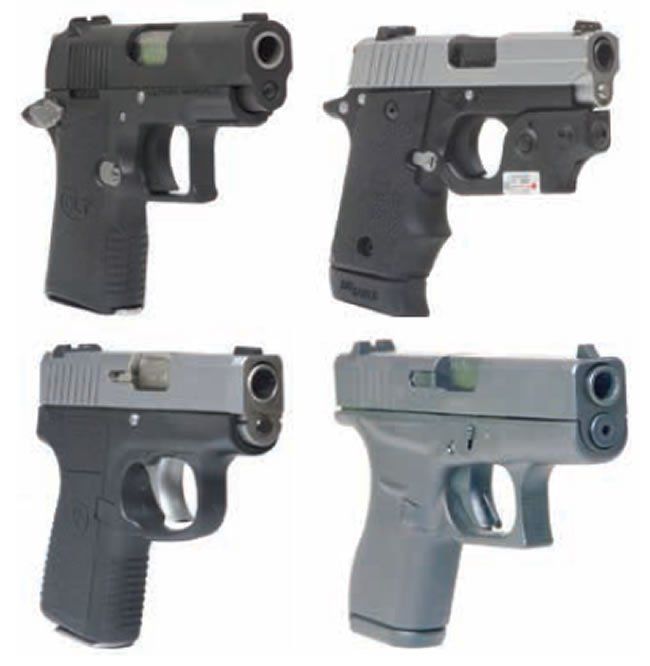
Many concealed-carry customers pooh-pooh pistols chambered in 380 ACP as being underpowered for self defense, but they may well be in the vocal minority, because sales of 380-chambered handguns and ammunition continues apace, with more of the smallish sidearms finding their way into pockets and purses than ever before. It can be argued, in fact, that Glock kept seeing its rivals sell so many inexpensive-to-make pocket pistols that the Austrians were forced into the U.S. 380 ACP market with the G42 just so they could grab a slice of the ever-growing pocket-pistol pie.
At Gun Tests, we have mined this lode plenty ourselves, finding quite a few worthy pocketguns and pocketguns-plus over the years. We have previously given A grades to a new CZ USA Model 83 No. 91302, a Bersa Firestorm, a Colt Mustang Pocketlite, and a Kel-Tec P3AT. A half-grade down at A- grades have been the Ruger LCP-CT, a used Beretta Model 84 and CZ Model 83, a Ruger LC380 No. 3219, and a Taurus 738B No. 1-73803. Our new e-book on 380s, available on the Gun-Tests.com website, recaps those guns and six more B+ or B pistols, or you can search for “380 ACP” in the archives and pull up the entire list of such firearms we’ve evaluated over the years.
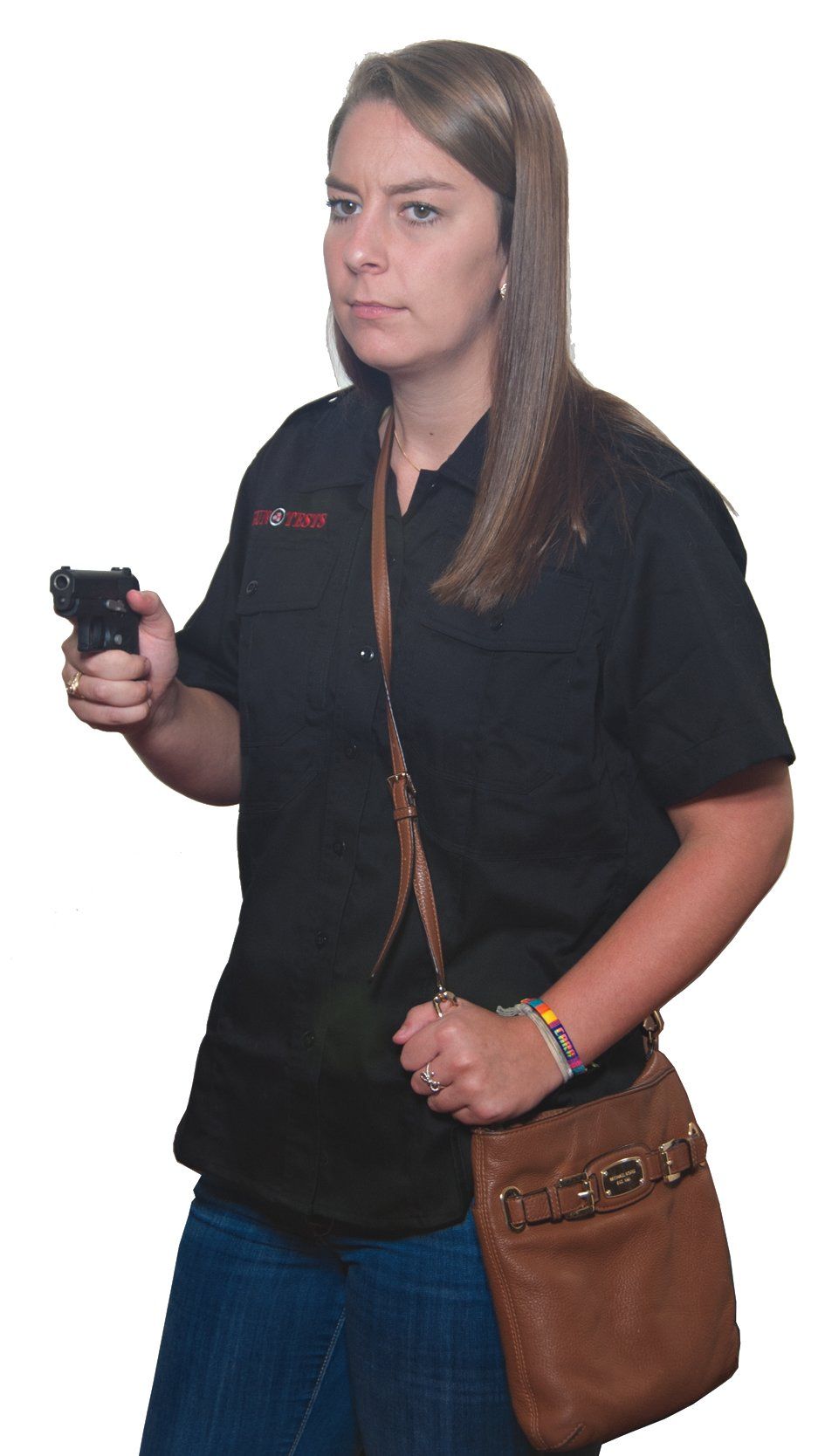
We think many consumers like these pistols because most of them are easy to carry and conceal, and they’re willing to trade off the “carry everywhere” portability for slightly less power than some 38 Specials, for example. Our tests of several 380 ACP self-defense loads had three (Federal 90-gr. Hydra-Shok JHP, Speer 90-gr. Gold Dot JHP, and Fiocchi 95-gr. FMJ) that penetrated at least 13.5+ inches in water, very close to what a Remington 125-gr. JHP 38 Sp. +P did as a control — and not too many experts say the 38 Special is “too little” gun.
This round, we tested three brand-new models and one variation of a previously tested model as a reference point. The first of the new models was the Colt Mustang XSP Pocketlite Polymer O6790, MSRP $649, but which we found at ImpactGuns.com for $565 and $572 at BudsGunShop.com. Or Bud’s would sell it for a cash price of $555. Next up was the Glock 42 Subcompact Slimline, MSRP $480, which SlickGuns.com had for sale at $490 plus free shipping. Bud’s listed it for $437 or $424 cash. Kahr’s CW 380 No. 3833, $419 MSRP, comes in at a $322 retail price at Bud’s or a $313 cash discount price. At GeorgiaGunStore.com, the price was $312. The fourth entry was a P238 from SIG Sauer, No. 238-380-NBS12, with a hefty MSRP of $710 and a retail price of $498 from Bud’s Gun Shop (but listed as out of stock the last time we checked), or $583 from TombstoneTactical.com or $520 from JoeBobOutfitters.com.
In more detail, the polymer Colt XSP is one of two Mustangs in the company’s 380 line. Colt ceased production of the Mustangs in 2000 then reintroduced the line in 2011. The new guns are designed to accept original parts. Both have stainless-steel slides, measure 5.5 inches in length, have 2.75-inch barrels, and operate with short single-action trigger function, or like miniature 1911s. The Mustang Pocketlite has an aluminum frame, while the XSP, introduced in 2013, has a lightweight polymer skin. According to company specs, the polymer XSP is about an ounce lighter than the Pocketlite.
The new Glock 42, made in Georgia, is a slimline subcompact pistol and is the smallest pistol Glock has ever introduced, but it’s not the company’s first 380 Auto. The Glock 25 was introduced in 1995 in Germany as a small-dimension firearm for markets where civilian personnel are not allowed to possess handguns featuring military calibers. In the USA, the G25 is reserved for law-enforcement agencies only. Like the G25, the Glock 28 is reserved for LE. The G25 is 7.36 inches long, 5 inches tall, and has a capacity of 15+1. The G28 is 6.41 inches long, 4.7 inches tall, and has a capacity of 10+1. Both are noticeably larger than our tested G42, which was 5.94 inches long, 4.13 inches tall, and has a capacity of 6+1. Marketed for pocket carry and to shooters with smaller hands, the single-stack G42 lacks the interchangeable backstraps of other Glocks, but field-strips the same way as other larger Glocks.
Introduced in 2014, the Kahr CW 380 No. 3833 is one of a line of “value” pistols, as opposed to the P Series pistols, which are Kahr’s premium polymer pistol with match-grade polygonal barrels, machined slide stops, dovetailed front sights, and slides with engraved markings and extensive cosmetic rounding. Also, P Series pistols are provided with three magazines. CW-Series pistols have Kahr’s set features but reduce production cost by using barrels with conventional rifling, making fewer operations on the slide exterior (simple roll markings and pinned front sights), and CW Series pistols use a metal-injection-molded slide stop. The CWs are shipped with one six-round steel magazine with flush baseplate. Like other Kahrs, the owner’s manual provided with the CW 380 recommends a 200-round break-in.
The P238 was introduced in 2009, and No. 238-380-NBS12 will be our third test of SIG Sauer’s small 380, but there’s plenty more where that one comes from. The company lists 18 P238s in a range of finishes and colors, and we have previously tried the 238-380-TL Tactical Laser and the No. 238-380-TSS Two Tone. Though the P238 mimics 1911 controls — slide stop, thumb safety, magazine release, SA trigger, and exposed hammer — the mechanism is quite different. We expected this one and the Colt to be the easiest to shoot well because of their single-action triggers, and we also liked the SIG’s large night sights. But because of the sights, the P238 needs to be carried in a holster or a large pocket, we found. The laser for the P238 was nicely integrated on the P238’s frame/receiver under the barrel and around the trigger guard.
How We Tested
To collect chronograph data, we set up at Tactical Firearms in Katy, Texas (TacticalFirearms.us). For bench-accuracy shooting at 10 yards, we fired the pistols off a Caldwell Shooting Supplies Matrix Rest ($50, #100-012-210WB) onto Birchwood-Casey BB-SI single-bull targets.
We fired two ball ammos and one jacketed hollowpoint, all purchased from MidwayUSA.com. The first was Prvi Partizan Ammunition 94-Grain Full Metal Jacket #PPR3.2, which were $17 per 50 rounds. This was the round we used for break-in of all the guns, which we ran to 200 shots on all four, since the Kahr manual specified that number. We also shot Winchester USA 95-grain Full Metal Jacket #USA380VP, which were $40 per 100 in the well-known white box. We fired the Hornady Critical Defense #90080 as an example of a self-defense round many shooters would prefer. Loaded with 90-grain Flex Tip eXpanding bullets, the Critical Defense rounds were a pricey $19.50 per 25 count, or 78 cents per bang.
We also had a variety of women from 21 to 60 years of age handle the pistols and comment on the slide-retraction effort needed to operate each one. And we pocket-carried each one for a week in a variety of clothing, including pants pockets, cargo-shorts pockets, workout shorts, and purses. Here’s how they performed:
Features:
The Glock 42 came in a plastic pistol case that contained a cable lock, manual, cleaning brush, and Glock patch and window sticker. In the case were two 6-round polymer magazines. The front sight was a black polymer front blade screwed into the top of the slide. The rear sight was also black polymer with a white squared U-shape framing the front-sight white dot. The rear sight was drift adjustable for windage. The frame and slide had marks designating that the gun was made in Georgia. Safeties include a firing pin safety and drop safety, as well as the lever in the Safe Action Trigger, but no conventional safety as on the Colt and SIG. The G42 is a single-action semi-auto that’s striker fired. The extractor serves as a loaded-chamber indicator. When the chamber is loaded, the extractor pivots out from the slide. The slide is black stainless steel with six rear serrations. The frame is, of course, black polymer, and the grip had a Gen4-like texture, but not as aggressive as on other Glocks. Warranty is a limited one-year agreement.
Made in Hartford, Connecticut, the Colt Mustang Pocketlite Polymer O6790 is a single-action semi-auto with a Commander-style hammer. It came with one six-round stainless-steel magazine, a plastic pistol case, a lock, manual, and chamber plug. While some basic features of the Mustang Pocketlite, such as size, magazine and slide, continue in the Mustang XSP, the polymer gun has some differences. The front blade is a black steel bar dovetailed into the slide. At the rear, the metal sight has a shallow, square notch. The rear sight was drift adjustable in a dovetail. The slide serrations on the XSP have been enhanced to offer an improved grip when working the slide. The XSP also features ambidextrous safeties, rather than the typical single-sided safety. An integral 3⁄8-inch accessory rail sits below the dust cover for easy mounting of lasers and lights, and a squared-off trigger guard allows those devices to be fitted more securely. A molded thumb perch sits under the XSP’s safeties, and a cut behind the trigger guard helps the gun sit lower in the user’s hand. The safety and slidestop profiles have been blended to reduce the gun’s profile. The slide and barrel are machined from stainless steel bar stock, and the slide has a blackened finish. The black polymer frame had a light texture on the sides of the grip and a checkered backstrap that was more aggressive than the Glock, we thought. Warranty is limited lifetime.
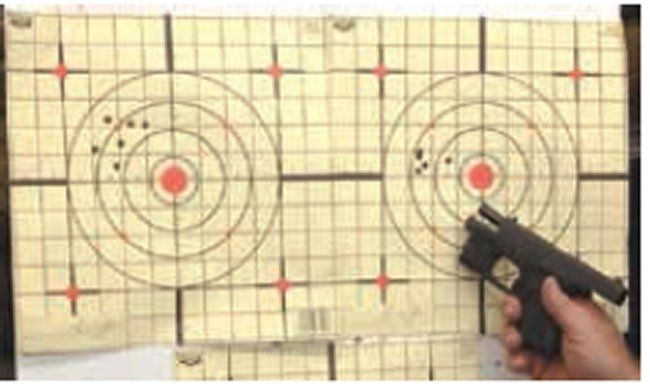
The SIG Sauer P238 came in a padded box, with a cable lock, manual, leather holster, and one 7-round stainless-steel magazine. It has been referred to as a Colt Mustang clone, but we would dispute that characterization. The P238’s single-action operation was described in the owner’s manual as a hammer-fired mechanically locked, short-recoil-operation blowback pistol with semi-automatic reloading. Our gun was built on an alloy frame with a Nitron-finished stainless-steel slide. The slide featured seven cocking serrations to the rear and SIGLite night sights dovetailed in front and back. The black anodized aluminum frame with beavertail was fitted with a one-piece black-rubber finger-groove grip held in place by Allen-head screws. The left side of the gun featured a grooved magazine button, slide stop and thumb safety each matching the slide. The thumb safety was left side only, and the right side of the pistol was accented with stainless steel pins. The backstrap was flat with vertical lines capping the mainspring housing and the surface along the front strap. The distance from the bottom of the trigger guard to the magazine well held two fingers comfortably in the grooves, with the pinkie wrapping underneath. A single flush-fit six-round magazine was supplied. As well as the night sights, this pistol came with a red SIG Sauer laser with ambidextrous push-button activation. The dot size was rated at 0.5 inch at 50 feet and allowed windage and elevation sight adjustments. It is powered by (1) CR1/3N lithium battery. There was no written warranty.
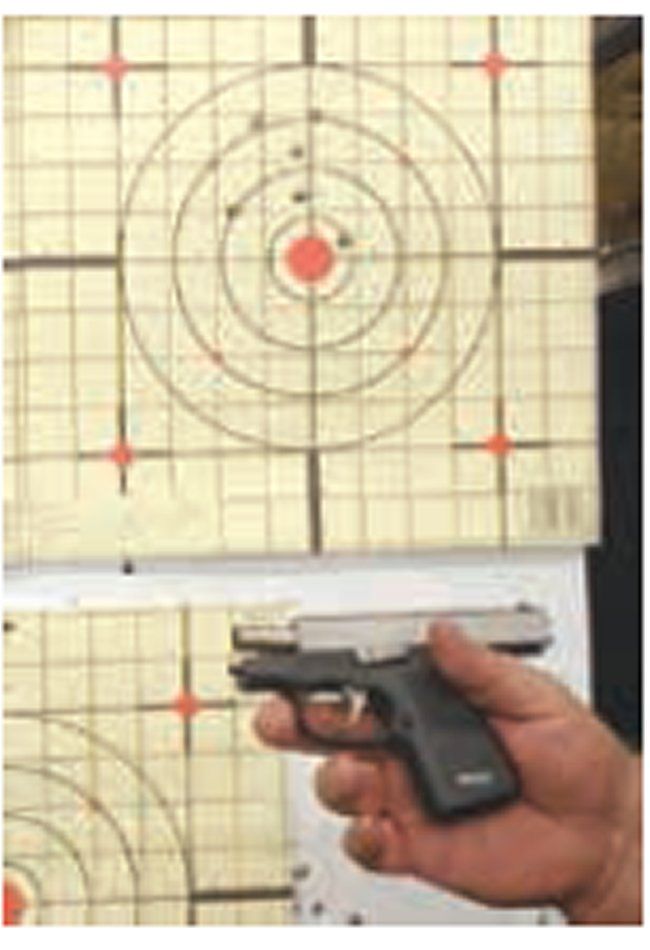
The Kahr CW 380 is a trigger-cocking DAO semi-auto that’s striker fired from a locked breech. Made in Worcester, Massachusetts, it came with one six-round stainless steel magazine with flush baseplate, a padded pistol box, lock, and manual. The slide is matte 416R stainless steel with eight rear serrations. The black-polymer frame has textured grip panels with a finish on par with the roughness of the Colt. The front sight is a pinned-in polymer bar with white dot. The rear sight is also made of black polymer, with a white bar below a notch. It’s drift adjustable in a dovetail. The safety is a passive striker block — there’s no external trigger safety or frame-mounted safety and no mag disconnect. Warranty is a limited five-year agreement.
Our Team Said: The Glock’s accessory package was the best, in our view, if we set aside the SIG’s laser for now and deal with it in the sights section. However, the SIG was a close second for the excellent holster that allowed open, load, and carry use out of the box. Only the Glock came with more than one magazine.
Dimensions and Weights
The Kahr CW 380 had an overall length of only 4.8 inches compared to the Colt XSP and SIG P238 (5.5 inches) and Glock 42 (5.94 inches). However, the Colt at 3.75 inches was the shortest in overall height, nudging out the Kahr (3.9), Glock (4.13), and SIG (4.3). The Kahr (0.92 inches) and the Glock (0.94) were noticeably thinner than the Colt (1.18) and SIG (1.22).
The Kahr was a featherweight in the pocket, weighing only 11.8 ounces unloaded and 14.4 ounces loaded. But Colt wasn’t far behind (12.8 and 15.4 ounces), followed by the G42 (14.0 and 16.6 ounces), and the P238 (17.0 and 20.0 ounces). Some of that was due to capacity, with the Kahr, Colt, and Glock at 6+1 and the P238 at 7+1. And some was due to barrel length, with the shortest tube belonging to the Kahr (2.58 inches), followed by the SIG (2.7 inches), Colt (2.75 inches), and Glock (3.25 inches).
The grips were more complicated to assess. The Kahr was certainly the smallest in the areas that count most: maximum grip thickness was 0.8 inches; grip circumference was 4.5 inches, the checkered frontstrap offered 1.28 inches of gripping surface and the checkered backstrap at 1.85 inches. The Colt, likewise, had a tiny grip, with a maximum grip thickness of 1.04 inches; grip circumference of 4.6 inches, a checkered frontstrap at 1.3 inches of gripping surface and the checkered backstrap at 2.0 inches. But that was too short for some men, who could only get about a finger and a half on the grip, which hurt controllability and accuracy. The Glock was slightly
better at a maximum grip thickness of 0.9 inches, grip circumference of 4.9 inches, a frontstrap at 1.55 inches, and the checkered backstrap at 2.1 inches. In the hand, our shooters preferred the feel of the P238’s grip, with a 1.22-inch grip thickness, 5.3-inch grip circumference, 1.93-inch frontstrap, and 2.38-inch backstrap, along with the rubber finger grooves and magazine extension. Adding Pearce Grip extensions (PG-42, $10) to the Glock magazines brings that gun alongside the P238 in grip comfort, our shooters said.
Our Team Said: The Kahr was easily the (small) size winner. When we placed it in pants or jacket pockets, it would disappear. The Colt was likewise easy to hide, with the Glock and SIG less so. Because of the SIG’s rubber grips, we wouldn’t want to carry it outside its holster because the rubber can grab material and impede a speedy draw.
Operation
Our shooters had some disagree-ments about the operations of the tested guns. In early handling, women and men with compromised grip strength vetoed the Kahr, grading its 19-pound slide retraction effort as an F. (Basically, this is a measure of the recoil spring strength, along with the slide’s slickness, texture, and slide height.) The Glock at 15 pounds bothered some women, and the Colt was stiff as well, but not as bad at 14 pounds. The SIG at 9 pounds of slide retraction effort with broad, easy-to-grasp serrations was the winner in this crucial area.
Assessing the controls was next, and our testers agreed that the Kahr and the Glock were brain-dead simple to operate. Neither had external controls other than the magazine release to fuss with, a marked contrast from the single-action SIG and Colt pistols with one-side and ambi safety levers, respectively.
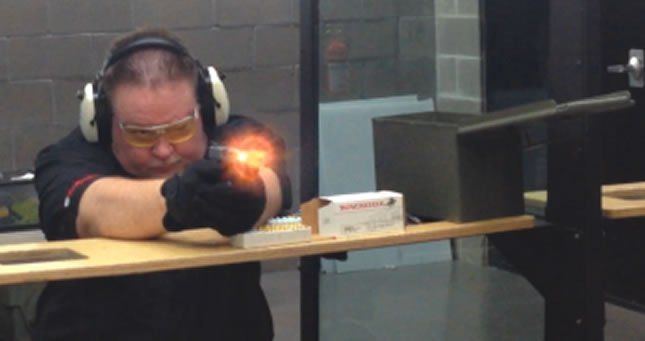
We expected the single-action handguns to easily beat the DAs, but that wasn’t the case. The SIG’s single-action break weight averaged out to be 8.0 pounds, but its break range was from 6.8 pounds to 8.8 pounds, depending on where the trigger finger met the shoe. At the bottom of the shoe, where the finger dragged on the guard, the break weight was lower. In the middle of the shoe, the break weight was higher. The inconsistency was irritating, of course. The Colt’s trigger-pull weight was marginally lighter at 7.5 pounds, but it had a spongy and indistinct break point. Still, they were better than the Kahr’s double-action break, which came at 6.4 pounds. Trigger travel to break on the Kahr was 0.65 inches, a long, gooey mess wherein the initial pull on the trigger didn’t require much effort, but then a second stage readying the action to fire occurred near the back of the trigger guard. The Glock likewise had its trademark take-up, but it broke consistently at 7.9 pounds.
The magazine releases on all four dumped the mags with little effort. The safeties on the Colt and SIG operated as we expected. The P238 and Colt’s thumb safeties can be left on while their slides are racked, unlike a standard 1911 and the SIG P938.
Our Team Said: We had some early malfunctions with all four, mainly failures to feed the blockish Winchester rounds, but those issues worked themselves out. The Glock could be used and understood by most shooters immediately, and it had the best trigger in this test. Before buying one, however, all women and many men should check to see if they can operate its slide.
Sights & Accuracy
This was another area in which our testers disagreed. The function of these firearms are as portable, carry-anywhere self-defense guns, and their sights aren’t made to win matches. How much aiming does a concealed-carrier have to do with a bad guy 15 feet away? Still, the sights on the Colt and the Kahr were abysmal, hard to see and regulate on a silhouette. The Glock and SIG sights were much better, in our opinion, and the lasers made us able to shoot them on par with much bigger guns. We mentioned the SIG’s red laser before, but we also added a Viridian Green Laser, just announced for the Glock 42, to our test gun. Viridian’s R5-G42 Reactor is the first green laser for the G42, and this model automatically ignites instantly when drawn from a supplied leather and polymer holster. Additional holster options are available from many holster manufacturers.
Unquestionably, the lasers helped our shooters’ accuracy. Shooting Winchester 95-grain FMJs, the average group size with a laser was 1.2 inches for the Glock and 1.8 inches for the SIG, noticeably better than we could do with the open sights (1.7 and 3.0 inches, respectively.) We saw the same group-size decrease with the Prvi Partizan 94-grain FMJs, with the Glock at a laser-aided 1.2 inches compared to open sights at 3.7 inches, and on the SIG, 1.8 inches with the factory laser and a whopping 4.0 inches with open sights. The trend continued with Hornady Critical Defense 90-grain FTEs, with the Glock and laser/open sights at 1.7/3.3 inches and the SIG at 1.6/2.8 inches.
Looking at only the open-sights results, the Glock was the most accurate with the Winchester fodder, 1.7 inches, followed by the Kahr (1.8), Colt (2.2) and SIG (3.0). With the Partizan, the Kahr led at 2.3 inches, followed by the Colt (2.5), Glock (3.7), and SIG (4.0). With Hornady rounds, the Kahr was again most accurate at 2.5 inches, followed by the SIG (2.8), Glock (3.3), and Colt (3.7). The SIG’s night sights didn’t seem to contribute much in getting rounds on target.
Our Team Said: The paper doesn’t lie — the Kahr was the most accurate pistol in the test when using open sights. But with a laser, the Glock easily beat the field.
Our Team Said:
We probably wouldn’t buy any of these guns if we could find a used, good-condition CZ 83. If we were looking for a pocket gun, we’d choose the Kel-Tec P3AT ahead of these. However, if you’ve got money burning a hole in your pocket, here’s what we recommend:
For a retail price at or below $440, we’d buy a Glock 42 Subcompact Slimline and add the Viridian R5-G42 Reactor Green Laser, $239. The G42 was big enough to shoot well and small enough to hide well. With the laser, it was very accurate. The controls, takedown, and maintenance are so easy an Austrian could do it. Would we buy the G42 by itself? Probably not.
The P238 from SIG Sauer, No. 238-380-NBS12, with a hefty $550-ish retail price that includes a laser and night sights, is a set of contradictions. It feels great in the hand, which makes it tougher to conceal. The single-action operation should have paid dividends in accuracy, but it didn’t. The trigger should have been noticeably better than a DAO gun, but it wasn’t.
We just can’t get excited about the Mustang XSP Pocketlite Polymer O6790 for around $570 — we get that some folks are Colt fanboys, but it’s too much money for too little performance, in our opinion.
There’s a lot not to like about the Kahr CW 380 No. 3833, which can probably be had for about $320. We hated its sights and its loooong DA trigger. It has a tiny grip that makes shooting it at the range not too much fun. And some folks will simply not be able to rack the slide, even using the proper technique. Yet this affordable gun shot more accurately than the others, can certainly hide better than the others, is simple to use (pull trigger, bang), and is easy to take apart for maintenance. So if you’re looking for a little gun to slip into your pants pocket for a midnight taquito run, you could do worse than the Kahr CW 380.
Written and photographed by Gun Tests staff,
using evaluations from Gun Tests team testers. GT

























